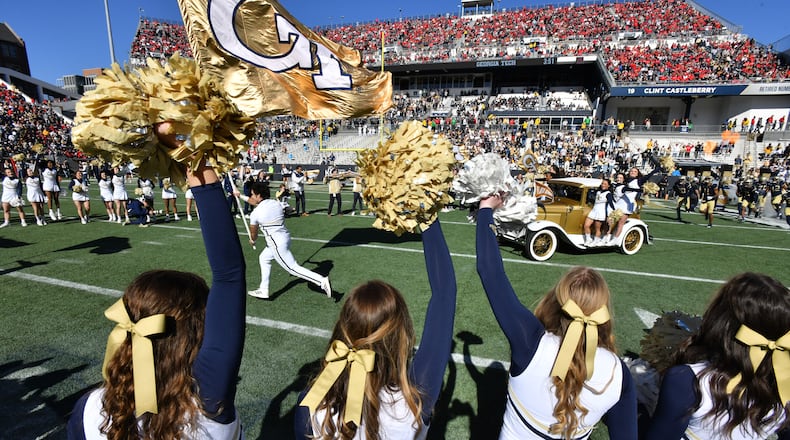There were two moments of clarity for Stephen Weitzel, a Georgia Tech alumnus and a major donor to the athletic department, about the need for supporters to form a group to support Yellow Jackets athletes’ endeavors to be compensated for the use of their name, image and likeness.
One was when star running back Jahmyr Gibbs transferred to Alabama. The other was when he learned that Grambling, an FCS school that last year had an average home football attendance of 7,532, had formed an NIL collective – an organization that is funded by a school’s supporters that seeks to compensate its athletes through NIL deals.
“We’re within the first 12 months of NIL actually being a thing,” Weitzel told The Atlanta Journal-Constitution. “But not having a public-facing NIL entity like this is really similar to being a major corporation in the mid-90′s that didn’t have a web page.”
Perhaps in a month’s time, Tech will have its web page, so to speak. Swarm the ATL, a collective that will compensate Yellow Jackets athletes for fan-engagement activities, has been incorporated and is expected to launch soon.
“We’ve got to get over that hump,” Weitzel said. “That’s what this is about.”
NCAA rules permitting college athletes to be paid for the use of their NIL went into effect in July. The collective has become perhaps the most prominent and widespread form of compensation.
No fewer than 38 colleges have an established collective, according to college sports media company On3, some more than one, including six ACC schools.
“I think it’s the new frontier,” said Corey Staniscia, external affairs director of Dreamfield, which has set up collectives for Florida State and Central Florida and will partner with Tech supporters for Swarm the ATL.
What gaudy locker rooms and stylish uniforms have been, NIL opportunities are the next step in convincing high-school prospects (and transfers) to align with your school. In March, the Athletic reported that a five-star recruit in the 2023 class had signed an NIL deal with a collective that could earn him $8 million before his senior year. A collective backing Texas athletes announced in December that it would give scholarship offensive linemen $50,000 annually to support their own charitable endeavors.
“People ask about NIL,” men’s basketball coach Josh Pastner told the AJC. “Not everybody does, but some do.”
And while athletes have and can pursue NIL opportunities outside of a collective, such an arrangement is different in that they are generally backed by school supporters seeking to ensure that their teams’ athletes are compensated.
“I think the NIL is important because it’s great for student-athletes to get extra opportunities,” Pastner said. “In reality, in today’s climate, for both recruiting and retention, NIL opportunities and collectives are important. However, everything still has to be done within NCAA rules.”
The collective will act something like a club. Fans can pay monthly fees and in return will receive access to Tech players and other perks. The price points will be $10, $25, $100, $250 and $500 per month, Weitzel said.
The access could take the form of a meet-and-greet, interaction over a videoconference, dinners or events like a trip to TopGolf. Weitzel tossed out the possibility of playing catch with Tech football players or shooting baskets with members of the basketball team.
Higher-level subscribers could have benefits like tickets to join suite owners for football games or sit courtside at basketball games.
“They’re going to get a lot of cool experiences out of this that they wouldn’t otherwise be able to,” Weitzel said. “And, in exchange for that, not only are they going to be able to get that cool stuff, they’re going to have some ownership in making sure that Georgia Tech athletics is on a more level playing field with schools in our conference, in our division.”
It is a model similar to the one set up at UCF and other schools.
“We don’t like to call ourselves a collective,” said Staniscia, the Dreamfield executive. “We like to call ourselves a university specific organization. What we’re really doing is building a platform for fan engagement and fan involvement. It really is the epitome of what NIL should be. We’re paying athletes to come out and do things with fans and not just paying athletes.”
Compensation will be determined by an advisory committee made up of engaged donors to the Tech athletic department. Weitzel said that compensation would be determined by the level of engagement by the athletes taking part in the collective (participation will be voluntary) and their market value. It would stand to reason that the athletes driving fans to subscribe would receive more.
The actual payment would depend on what sort of income that the collective receivers. (Dreamfield will take 15% of money received, Weitzel said.) At the UCF and FSU collectives, both launched within the past two months, membership numbers are well into the triple digits, Staniscia said. His hope for the start of the collective is the same he held for FSU and UCF – 100 subscribers in the first 10 days.
“I don’t think anybody’s going to get rich and I don’t think anybody’s buying a Ferrari, but we are here to share the wealth, share the love, and make sure that we take care of all Georgia Tech student-athletes,” Staniscia said.
Barring unforeseen success with the Tech NIL, the compensation likely won’t reach the levels of the monoliths of college athletics.
“We’re not trying to be Alabama,” Weitzel said. “We’re not trying to be Texas. But we’re trying to make sure that we’re on par with the other teams in our league.”
To that end, he called on Tech supporters to join. To fans who have complained about Tech teams’ performance or recruiting, “if you’re not taking two of my suite tickets, if I don’t see you in the suite, then I don’t want to hear it.”
About the Author
Keep Reading
The Latest
Featured


